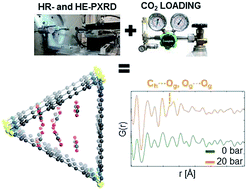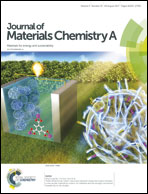Elucidating the CO2 adsorption mechanisms in the triangular channels of the bis(pyrazolate) MOF Fe2(BPEB)3 by in situ synchrotron X-ray diffraction and molecular dynamics simulations†
Abstract
The structural origin of the remarkable performance of the metal–organic framework Fe2(BPEB)3 as a CO2 adsorbent (40.5% of the host weight at 298 K and 10 bar) was investigated by combining advanced experimental and computational tools. In situ and operando high-resolution and high-energy powder X-ray diffraction experiments were carried out at 273 and 298 K dosing CO2 in the pressure range of 0–9 bar and 0–21 bar, respectively. Juxtaposing a conventional approach for structural determination and refinement with total scattering analysis enabled us to unveil the adsorption sites occupied by the gaseous probe and the host–guest interactions at 298 K and all the assayed pressures. These studies were complemented by molecular dynamics simulations to support the location of the guest molecules inside the host channels and characterize the energetics of the host–guest and guest–guest interactions. Our molecular-level insight into the nature of the host–guest interactions in Fe2(BPEB)3, a rigid host without exposed metal sites or functional groups with particular affinity to CO2 on the ligand, provides key information on a debated topic, namely the chemical and structural properties a host should possess for efficient CO2 adsorption under rather mild conditions.



 Please wait while we load your content...
Please wait while we load your content...